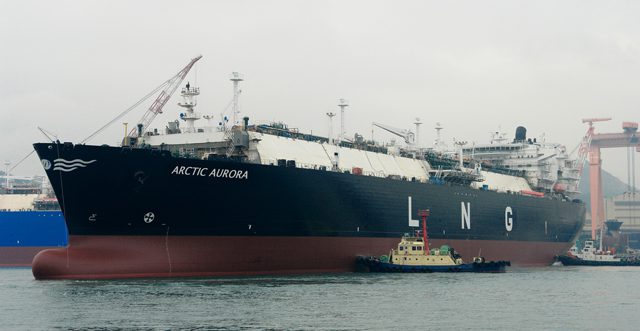Oct. 1 (Bloomberg) — Japan is set to receive its second spot cargo of liquefied natural gas from Norway via the Northern Sea Route as the world’s largest buyer of the fuel reaches further afield to secure supplies.
LNG replaced nuclear energy as Japan’s primary source of power generation after the most of the country’s atomic capacity shut after the March 2011 earthquake. It imported a record 87.3 million metric tons last year and paid 6 trillion yen ($61 billion), double the bill in 2011, according to customs data.
The Arctic Aurora, with a capacity of about 155,000 cubic meters, is scheduled to arrive Oct. 16 at the Futtsu LNG terminal owned by Tokyo Electric Power Co., according to transmissions captured by IHS Fairplay on Bloomberg. The company doesn’t comment on specific spot deals, Kaoru Suzuki, a company spokeswoman, said by phone from Tokyo.
Tepco could be buying this cargo as a “bargaining chip” for the review of its supply contract price formulas, according to Osamu Fujisawa, an independent energy economist in Tokyo. Long-term LNG contracts, typically for more than 10 years, are usually settled on the basis of a formula linked to Brent oil or the Japan Crude Cocktail price.
The Arctic Aurora is delivering Japan’s second cargo from Norway this year, according to data compiled by Bloomberg. The vessel loaded the supercooled gas at Statoil ASA’s Hammerfest LNG terminal in northern Norway and departed Sept. 19, ship- tracking data show.
The ship used the Northern Sea Route to sail to Norway after completing its trials in South Korea last month. The route reduces the sailing time between Europe and Asia and can be used by ships from July to November, when ice is reduced.
Higher Freight
“The freight cost must be higher than cargoes from other origins because they have to use ice-class LNG carriers to sail the Arctic Sea,” said Fujisawa. “So it’s hard for me to believe this cargo has economical rationality.”
The Ob River was the first LNG vessel to sail the northern passage in October 2012. It loaded an LNG cargo at Hammerfest that was delivered Dec. 5 to Kita-Kyushu LNG’s terminal in Tobata, southern Japan.
Tepco’s Futtsu plant has a capacity of 20.2 million tons a year and receives long-term shipments from Indonesia, Malaysia, Qatar, Australia, Oman, Abu Dhabi, Brunei and Russia, data compiled by Bloomberg show. Tepco, the world’s largest power utility serving 29 million people in the Tokyo metropolitan area, has no supply contract with Statoil.
Japan has had no nuclear power since Kansai Electric Power Co. started maintenance at its Ohi No. 3 nuclear reactor on Sept. 2 and shut its Ohi No. 4 plant on Sept. 15. Japan will buy about 90 million tons of LNG this year and in 2014, according to a report by Sanford C. Bernstein in August.
– Chou Hui Hong, Copyright 2013 Bloomberg.

 Join The Club
Join The Club










